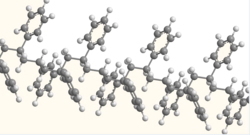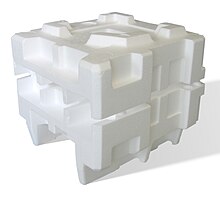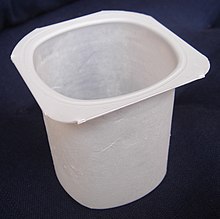പോളി സ്റ്റൈറീൻ

| |

| |
| Names | |
|---|---|
| IUPAC name
Poly(1-phenylethene)
| |
| Other names
Thermocol
| |
| Identifiers | |
| Abbreviations | PS |
| ChemSpider |
|
| ECHA InfoCard | 100.105.519 |
CompTox Dashboard (EPA)
|
|
| Properties | |
| തന്മാത്രാ വാക്യം | |
| Molar mass | 0 g mol−1 |
| സാന്ദ്രത | 0.96–1.04 g/cm3 |
| ദ്രവണാങ്കം | |
| Insoluble | |
| Solubility | Soluble in benzene, carbon disulfide, chlorinated aliphatic hydrocarbons, chloroform, cyclohexanone, dioxane, ethyl acetate, ethylbenzene, MEK, NMP, THF [1] |
| Thermal conductivity | 0.033 W/(m·K) (foam, ρ 0.05 g/cm3)[2] |
| Refractive index (nD) | 1.6; dielectric constant 2.6 (1 kHz – 1 GHz)[3] |
Except where otherwise noted, data are given for materials in their standard state (at 25 °C [77 °F], 100 kPa).
| |
പോളി സ്റ്റൈറീൻ, സുതാര്യവും, വിവിധ വർണ്ണങ്ങളിലും രൂപങ്ങളിലും എളുപ്പം രൂപപ്പെടുത്തിയെടുക്കാവുന്ന തെർമോപ്ലാസ്റ്റിക് ആണ് സ്റ്റൈറോഫോം, തെർമോക്കോൾ എന്നീ പേരുകളിൽ നമുക്കു സുപരിചിതമായ പാക്കിംഗ് പദാർത്ഥം പോളി സ്റ്റൈറീൻറെ അനവധി രൂപങ്ങളിലൊന്നാണ്.
രസതന്ത്രം[തിരുത്തുക]
സ്റ്റൈറീൻ, ( വൈനൈൽ ബെൻസീൻ, എന്നും പറയാം) തന്മാത്രകളുടെ ശൃംഖലയാണ് പോളി സ്റ്റൈറീൻ.
സൊല്യൂഷൻ ,എമൾഷൻ എന്നീ രീതികളിലും പോളിമറീകരിക്കാമെങ്കിലും ബൾക്ക്, സസ്പെൻഷൻ എന്നീ രീതികളാണ് സാധാരണ പോളിമറീകരണം നടത്താറ്.
ഫ്രീ റാഡിക്കൽ പോളിമറൈസേഷൻ അറ്റാക്റ്റിക് ശൃംഖലയാണ് നൽകുക. അതായത് ഫിനൈൽ ഗ്രൂപ്പുകൾ അടുക്കും ചിട്ടയുമില്ലാതെ ശൃംഖലയുടെ ഇരു വശത്തുമായിരിക്കും, അതുകൊണ്ട് ഉത്പന്നം അമോർഫസും. എന്നാൽ കോഡിനേഷൻ പോളിമറൈസേഷൻ വഴി ഫിനൈൽ ഗ്രൂപ്പുകൾ ഒന്നിടവിട്ട് ശൃംഖലയുടെ ഇരു ഭാഗത്തും ക്രമീകരിച്ച ക്രിസ്റ്റലൈനിറ്റിയുളള സിൻറിയോടാക്റ്റിക് പോളിമറാണ് ലഭിക്കുക
| Properties | |
|---|---|
| Density | 1.05 g/cm3 |
| Density of EPS | 16–640 kg/m3[5] |
| Dielectric constant | 2.4–2.7 |
| Electrical conductivity (s) | 10−16 S/m |
| Thermal conductivity (k) | 0.036 W/(m·K) |
| Young's modulus (E) | 3000–3600 MPa |
| Tensile strength (st) | 46–60 MPa |
| Elongation at break | 3–4% |
| Notch test | 2–5 kJ/m2 |
| Glass transition temperature | 95 °C |
| Melting point[6] | 240 °C |
| Vicat B | 90 °C[7] |
| Linear expansion coefficient (a) | 8×10−5 /K |
| Specific heat (c) | 1.3 kJ/(kg·K) |
| Water absorption (ASTM) | 0.03–0.1 |
| Decomposition | X years, still decaying |
ഗുണങ്ങൾ[തിരുത്തുക]
റിഫ്രാക്റ്റീവ് ഇൻഡെക്സ് 1.6 ആയ അമോർഫസ് പോളി സ്റ്റൈറീന് വെട്ടിത്തിളങ്ങുന്ന സുതാര്യതയാണ്. ഓപ്റ്റിക്കൽ മേഖലകളിൽ സ്ഫടികത്തിനു പകരം ഉപയോഗപ്രദമാവുന്നു. ഒരു നല്ല ഇലക്ട്രിക്കൽ ഇൻസുലേറ്ററു കൂടിയാണ്. പക്ഷെ, പോളി സ്റ്റൈറീൻ. . എളുപ്പത്തിൽ പൊട്ടുന്നു, പല ലായകങ്ങളിലും എളുപ്പത്തിൽ അലിയുന്നു; 80 ഡിഗ്രി സെൽഷ്യസിൽ മൃദുവാകാനാരംഭിക്കുന്നു( Heat Distortion Temperature). അതിനാൽ കോപോളിമറൈസേഷനിലൂടേയും ക്രോസ്സ് ലിങ്കിങ്ങ് വഴിയും, ഗുണങ്ങൾ മെച്ചപ്പെടുത്താനുളള ശ്രമങ്ങൾ ഉണ്ടായിട്ടുണ്ട്.
ഉപയോഗമേഖലകൾ[തിരുത്തുക]
ആഗോളാടിസ്ഥാനത്തിൽ ഉത്പാദിപ്പിക്കപ്പെടുന്ന പോളിസ്റ്റൈറീൻറെ സിംഹഭാഗവും, പാക്കിംഗിനായി ഉപയോഗിക്കപ്പെടുന്നു.


അവലംബം[തിരുത്തുക]
- ↑ Wypych, George (2012). "PS polystyrene". Handbook of Polymers. pp. 541–7. doi:10.1016/B978-1-895198-47-8.50162-4. ISBN 978-1-895198-47-8.
- ↑ Haynes 2011, പുറം. [പേജ് ആവശ്യമുണ്ട്].
- ↑ Haynes 2011, പുറങ്ങൾ. 13–17.
- ↑ Wunsch, J.R. (2000). Polystyrene – Synthesis, Production and Applications. iSmithers Rapra Publishing. p. 15. ISBN 978-1-85957-191-0. Retrieved 25 July 2012.
- ↑ K. Goodier (June 22, 1961). "Making and using an expanded plastic". New Scientist. 240: 706.[പ്രവർത്തിക്കാത്ത കണ്ണി]
- ↑ International Labour Organisation chemical safety card for polystyrene. Inchem.org (2004-01-21). Retrieved on 2011-12-25.
- ↑ A.K. van der Vegt & L.E. Govaert, Polymeren, van keten tot kunstof, ISBN 90-407-2388-5
- Articles with dead external links from നവംബർ 2023
- Chemicals that do not have a ChemSpider ID assigned
- Chemicals without a PubChem CID
- Articles without InChI source
- Articles without EBI source
- Articles without KEGG source
- Articles without UNII source
- ECHA InfoCard ID from Wikidata
- Chembox image size set
- പോളിമറുകൾ
